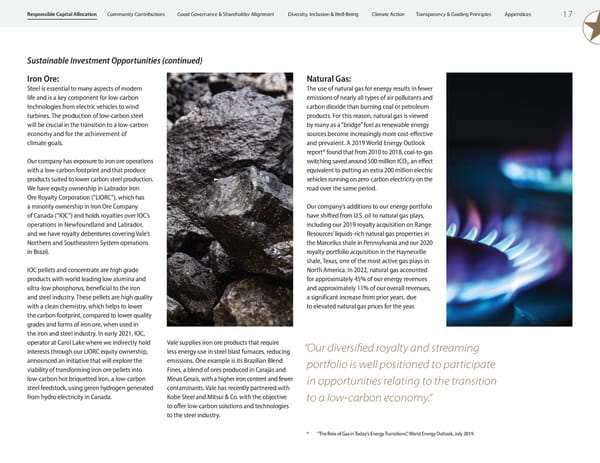Responsible Capital Allocation Community Contributions Good Governance & Shareholder Alignment Diversity, Inclusion & Well-Being Climate Action Transparency & Guiding Principles Appendices 17 Sustainable Investment Opportunities (continued) Iron Ore: Natural Gas: Steel is essential to many aspects of modern The use of natural gas for energy results in fewer life and is a key component for low-carbon emissions of nearly all types of air pollutants and technologies from electric vehicles to wind carbon dioxide than burning coal or petroleum turbines. The production of low-carbon steel products. For this reason, natural gas is viewed will be crucial in the transition to a low-carbon by many as a “bridge” fuel as renewable energy economy and for the achievement of sources become increasingly more cost-effective climate goals. and prevalent. A 2019 World Energy Outlook report* found that from 2010 to 2018, coal-to-gas Our company has exposure to iron ore operations switching saved around 500 million tCO , an effect 2 with a low-carbon footprint and that produce equivalent to putting an extra 200 million electric products suited to lower carbon steel production. vehicles running on zero-carbon electricity on the We have equity ownership in Labrador Iron road over the same period. Ore Royalty Corporation (“LIORC”), which has a minority ownership in Iron Ore Company Our company’s additions to our energy portfolio of Canada (“IOC”) and holds royalties over IOC’s have shifted from U.S. oil to natural gas plays, operations in Newfoundland and Labrador, including our 2019 royalty acquisition on Range and we have royalty debentures covering Vale’s Resources’ liquids-rich natural gas properties in Northern and Southeastern System operations the Marcellus shale in Pennsylvania and our 2020 in Brazil. royalty portfolio acquisition in the Haynesville shale, Texas, one of the most active gas plays in IOC pellets and concentrate are high grade North America. In 2022, natural gas accounted products with world leading low alumina and for approximately 45% of our energy revenues ultra-low phosphorus, beneficial to the iron and approximately 11% of our overall revenues, and steel industry. These pellets are high quality a significant increase from prior years, due with a clean chemistry, which helps to lower to elevated natural gas prices for the year. the carbon footprint, compared to lower quality grades and forms of iron ore, when used in the iron and steel industry. In early 2021, IOC, operator at Carol Lake where we indirectly hold Vale supplies iron ore products that require “Our diversified royalty and streaming interests through our LIORC equity ownership, less energy use in steel blast furnaces, reducing announced an initiative that will explore the emissions. One example is its Brazilian Blend portfolio is well positioned to participate viability of transforming iron ore pellets into Fines, a blend of ores produced in Carajás and low-carbon hot briquetted iron, a low-carbon Minas Gerais, with a higher iron content and fewer in opportunities relating to the transition steel feedstock, using green hydrogen generated contaminants. Vale has recently partnered with from hydro electricity in Canada. Kobe Steel and Mitsui & Co. with the objective to a low-carbon economy.“ to offer low-carbon solutions and technologies to the steel industry. * “The Role of Gas in Today’s Energy Transitions”, World Energy Outlook, July 2019.
 2023 ESG Report | Franco-Nevada Page 18 Page 20
2023 ESG Report | Franco-Nevada Page 18 Page 20